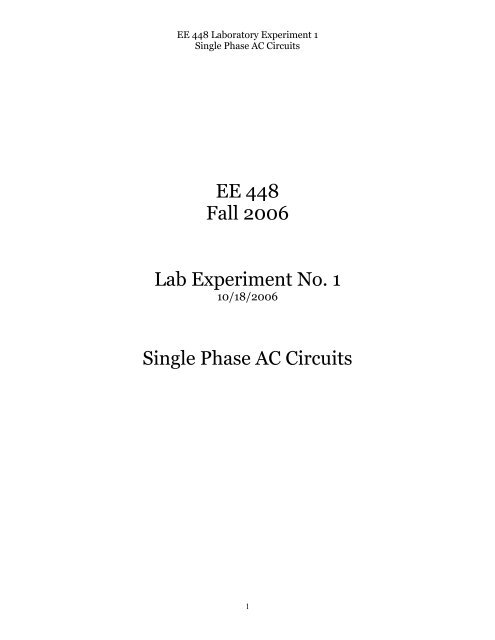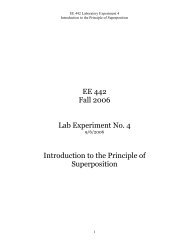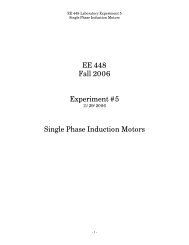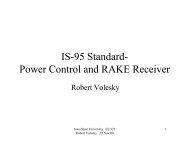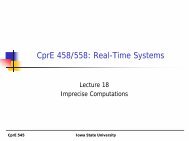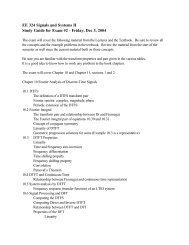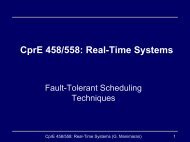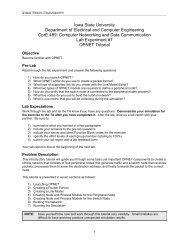EE 448 Fall 2006 Lab Experiment No. 1 Single Phase AC Circuits
EE 448 Fall 2006 Lab Experiment No. 1 Single Phase AC Circuits
EE 448 Fall 2006 Lab Experiment No. 1 Single Phase AC Circuits
Create successful ePaper yourself
Turn your PDF publications into a flip-book with our unique Google optimized e-Paper software.
<strong>EE</strong> <strong>448</strong> <strong>Lab</strong>oratory <strong>Experiment</strong> 1<br />
<strong>Single</strong> <strong>Phase</strong> <strong>AC</strong> <strong>Circuits</strong><br />
<strong>EE</strong> <strong>448</strong><br />
<strong>Fall</strong> <strong>2006</strong><br />
<strong>Lab</strong> <strong>Experiment</strong> <strong>No</strong>. 1<br />
10/18/<strong>2006</strong><br />
<strong>Single</strong> <strong>Phase</strong> <strong>AC</strong> <strong>Circuits</strong><br />
1
<strong>EE</strong> <strong>448</strong> <strong>Lab</strong>oratory <strong>Experiment</strong> 1<br />
<strong>Single</strong> <strong>Phase</strong> <strong>AC</strong> <strong>Circuits</strong><br />
I. INTRODUCTION<br />
OBJECTIVES:<br />
• Study the phasor relationship between Voltage and Current in a<br />
single phase <strong>AC</strong> Circuit.<br />
• Study the concept of real power (P), reactive power (Q), apparent<br />
power(S) and power factor (cosΦ).<br />
• Identify a method to improve the line side power factor with the help<br />
of a capacitor bank.<br />
B<strong>AC</strong>KGROUND SUMMARY:<br />
<strong>AC</strong> circuit elements consist of resistors (R), inductors (L) and<br />
capacitors(C) which can be fed from either a 3 phase or 1 phase 60 Hz,<br />
120V source. Resistor and inductor combination connected to a single<br />
phase <strong>AC</strong> source results in a lagging current with respect to voltage. If R &<br />
L are connected in series, the phasor sum of the voltages across L and R<br />
equals the source voltage. In contrast if they are connected in parallel the<br />
phasor sum of the currents drawn by R & L equals the source current.<br />
Power factor of any load (source) is defined as the cosine of the angle<br />
between the load(source) current and corresponding load(source) voltage.<br />
By connecting a capacitor bank in parallel with such a RL circuit can<br />
improve the power factor which in turn reduces the current drawn from<br />
the source for a given power drawn by the resistor.<br />
Power relations in a single phase system<br />
Real power =V rms *I rms cosΦ in watts (where Φ is angle between V and I)<br />
Reactive power = V rms *I rms * sin(Φ) in VARs<br />
Apparent power = V rms *I rms in VA<br />
INSTRUMENTS and COMPONENTS:<br />
Power Supply Module EMS 8821<br />
<strong>AC</strong> Voltmeter Module EMS 8426<br />
<strong>AC</strong> Current Meter ModuleEM.S 8428<br />
Resistance Module EMS 8311<br />
Inductance Module EMS 8321<br />
Capacitance Module EMS 8421<br />
2
<strong>EE</strong> <strong>448</strong> <strong>Lab</strong>oratory <strong>Experiment</strong> 1<br />
<strong>Single</strong> <strong>Phase</strong> <strong>AC</strong> <strong>Circuits</strong><br />
II.<br />
Pre-<strong>Lab</strong> Test Questions and Calculations<br />
1. The machines we will be working with in this lab have these<br />
resistances: R 1 = 300Ω, R 2 = 600Ω and R 3 = 1200Ω. Identify the<br />
parallel combinations of two of the resistors at a time to get equivalent<br />
resistances of 200Ω, 240Ω and 400Ω. This will make using the lab<br />
equipment easier.<br />
2. If R 1 = 300Ω is connected in series with an inductive reactance of X 1 =<br />
j300Ω, what will be the impedance angle of this series combination<br />
3. In Fig. 2, If R 1 and X 1 are connected in parallel across a single phase<br />
source. What capacitance C value should be connected in parallel to<br />
get unity p.f. Assume the frequency of supply is 60Hz.<br />
4. Draw the phasor diagrams for the voltages in figure 1. Take voltage<br />
across the resistor (V r ) as the reference vector.<br />
120Vrms<br />
60Hz<br />
V1<br />
300<br />
1<br />
j300<br />
2<br />
Figure 1<br />
5. For the circuit in Fig.2, draw the phasor diagram for the three currents<br />
I s , I r and I 1 and prove that I s = √2(I r ).<br />
120Vrms<br />
60Hz<br />
V1<br />
Is<br />
Ir<br />
300<br />
1<br />
Il<br />
j300<br />
2<br />
Figure 2<br />
3
6. For the circuit in Fig. 3 find<br />
<strong>EE</strong> <strong>448</strong> <strong>Lab</strong>oratory <strong>Experiment</strong> 1<br />
<strong>Single</strong> <strong>Phase</strong> <strong>AC</strong> <strong>Circuits</strong><br />
a) All the currents<br />
b) Real power supplied by the source<br />
c) Reactive power supplied by the source<br />
d) Apparent power supplied by the source<br />
e) Power dissipated in the resistor<br />
f) Real and reactive power in the inductor<br />
g) Real and reactive power in the capacitor<br />
h) Power factor as seen by the source<br />
Assume the source voltage as reference ׃ 120∟o°<br />
Is<br />
2<br />
Il<br />
Ir<br />
Ic<br />
120Vrms<br />
60 Hz<br />
V1<br />
j300<br />
300<br />
-j200<br />
1<br />
Figure 3<br />
III.<br />
PROCEDURE<br />
NOTE:<br />
Whenever an ammeter is used to measure current in a circuit, one should<br />
try to get the most accurate reading. To get a more accurate measurement<br />
the DMM(Digital Multi-Meter) should be used. However the DMM is only<br />
rated for 3 AMPS MAX! The <strong>Lab</strong>-Volt ammeters are rated for 8 amps. In<br />
most of our circuits the current is below 3 amps, but be sure to check your<br />
calculations of the circuit to determine whether to use the DMM or <strong>Lab</strong>-<br />
Volt ammeter for your measurements.<br />
1. Connect the circuit as shown in Figure 4. The transformer is necessary<br />
to isolate the scope ground from the line voltage.<br />
4
<strong>EE</strong> <strong>448</strong> <strong>Lab</strong>oratory <strong>Experiment</strong> 1<br />
<strong>Single</strong> <strong>Phase</strong> <strong>AC</strong> <strong>Circuits</strong><br />
2. Observe the voltage waveforms of V s and V r on the oscilloscope and<br />
identify the phase difference between these two voltages.<br />
3. Disconnect only the inductor and measure the phase difference between<br />
V s and V r .<br />
4. <strong>No</strong>w reconnect the inductor, remove the resistor and measure the phase<br />
difference between V s and V 1 . Does the data from the previous steps<br />
match your calculations for step 4 of part II<br />
5. Connect the circuit as shown in Figure 5.<br />
6. Measure the currents A s , A r and A 1 .<br />
a. Does the data from steps e and f match your calculations from<br />
step 5 of part II<br />
7. Calculate the power delivered to the circuit.<br />
8. Calculate the p.f. of the load.<br />
9. Make the circuit connections as shown in Figure 6. Connect R, L & C in<br />
parallel according to the table given below. First three readings are for<br />
R&L combinations. Last two readings are for R, L & C combinations.<br />
NOTE:<br />
The toggle switches on the inductance, resistance, and capacitive boxes<br />
work as follows. A toggle switch in the down position means that item is<br />
not in the circuit between the two banana plugs. When switched to the<br />
up position, the item is part of the circuit. When two or more toggle<br />
switches are up, those two or more items will be in the circuit connected<br />
in parallel. Depending on whether it’s a resistor, inductor, or capacitor<br />
box will determine the value of the parallel connection.<br />
10. Record your measurements in the table below.<br />
Use V = 120V<br />
I S P R Xi Xc p.f. Q=sin φ<br />
300 j300 -<br />
600 j300 -<br />
1200 j300 -<br />
600 j300 -j300<br />
600 j600 -j300<br />
5
-<br />
<strong>EE</strong> <strong>448</strong> <strong>Lab</strong>oratory <strong>Experiment</strong> 1<br />
<strong>Single</strong> <strong>Phase</strong> <strong>AC</strong> <strong>Circuits</strong><br />
-<br />
11. From looking at the table, which set of values will produce a unity power<br />
factor<br />
12. Study your data and determine the capacitance value that gave you the<br />
best power factor (closest to unity). Does this value match what you<br />
predicted in step 3 of part II Why or why not<br />
13. Again study your data and determine why it might be an important goal<br />
to achieve a power factor that is as close to unity as possible.<br />
14. Present the lab results using a spreadsheet computer program and attach<br />
it with your lab report.<br />
1 2<br />
1 2<br />
3<br />
5<br />
3<br />
5<br />
Transformer<br />
8341<br />
4<br />
6<br />
4<br />
6<br />
+<br />
1<br />
+<br />
1<br />
1<br />
+<br />
1<br />
+<br />
Digital<br />
Ammeter<br />
120 V<br />
<strong>AC</strong> Source<br />
8821<br />
2<br />
3<br />
N<br />
2<br />
3<br />
4<br />
Voltmeter<br />
-<br />
2<br />
-<br />
Vr<br />
R1<br />
+<br />
-<br />
Vl<br />
L1<br />
1 2<br />
+<br />
-<br />
2<br />
300<br />
j300<br />
1 2<br />
A<br />
B<br />
Oscilloscope<br />
3 4<br />
Gnd 1 Gnd 2<br />
Resistor Module – 8311<br />
Inductor Module – 8321<br />
Transformer – 8341<br />
<strong>AC</strong> Source – 8821<br />
Figure 4<br />
6
<strong>EE</strong> <strong>448</strong> <strong>Lab</strong>oratory <strong>Experiment</strong> 1<br />
<strong>Single</strong> <strong>Phase</strong> <strong>AC</strong> <strong>Circuits</strong><br />
+<br />
Ammeter<br />
1 2<br />
+ -<br />
-<br />
-<br />
R1<br />
300<br />
-<br />
1<br />
2<br />
L1<br />
j300<br />
-<br />
-<br />
+<br />
As<br />
1<br />
1<br />
+<br />
1<br />
120 V<br />
<strong>AC</strong> Source<br />
8821<br />
2<br />
3<br />
2<br />
3<br />
Voltmeter<br />
1<br />
+<br />
+<br />
1<br />
+<br />
+<br />
N<br />
4<br />
2<br />
-<br />
Ammeter<br />
Ar<br />
Digital<br />
Ammeter<br />
Al<br />
2<br />
-<br />
2<br />
-<br />
Resistor Module – 8311<br />
Inductor Module – 8321<br />
<strong>AC</strong> Source – 8821 (Power Supply)<br />
Figure 5<br />
+<br />
Digital<br />
Ammeter<br />
1 2<br />
+ -<br />
-<br />
1<br />
1<br />
Wattmeter<br />
3<br />
3<br />
2<br />
2<br />
4<br />
4<br />
1<br />
+<br />
+<br />
1<br />
1<br />
120 V<br />
<strong>AC</strong> Source<br />
8821<br />
2<br />
3<br />
N<br />
2<br />
3<br />
4<br />
Voltmeter<br />
R1<br />
300<br />
2<br />
L1<br />
j300<br />
C1<br />
-j300<br />
2<br />
-<br />
1<br />
Resistor Module – 8311<br />
Inductor Module – 8321<br />
Capacitor Module – 8331<br />
<strong>AC</strong> Source – 8821<br />
Figure 6<br />
7


